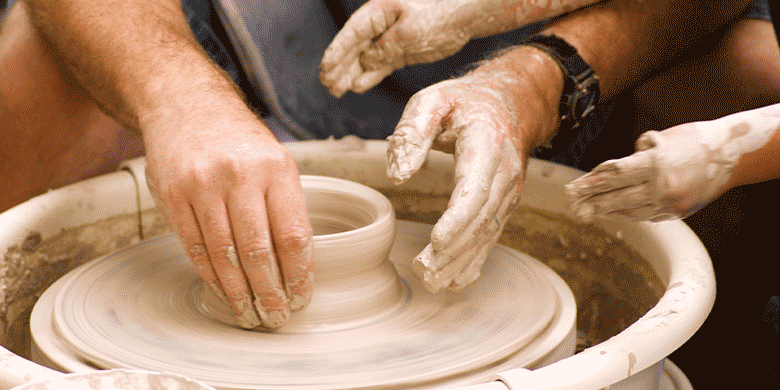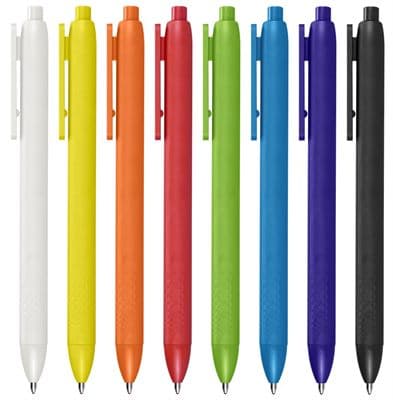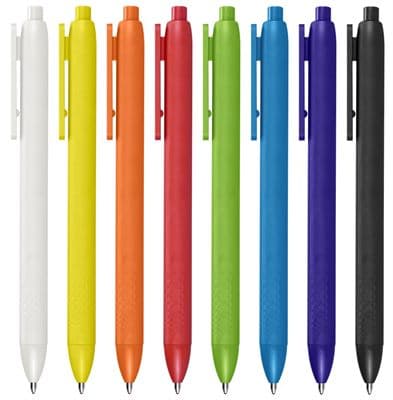
15 September, 2023
From Nature to Noteworthy: The Art of Crafting Eco-Friendly Pens
Eco-friendly promotional products are one way businesses are showing they care and one important item they use are pens made from renewable and biodegradable materials. Among the various options available, bamboo pens, recycled paper pens, plant starch pens, recycled plastic pens, and wheat straw pens stand out as excellent choices for companies looking to go green while leaving a lasting impression.
Bamboo Pens

Bamboo, known for its rapid growth and natural strength, has emerged as a favoured material for eco-conscious entrepreneurs. Many styles are available from push button, twist action, silver clips or stylus styles. They are lightweight and comfortable to use and biodegradable, making them an ideal choice for businesses striving to reduce their environmental impact. They can be branded with either a pad print, full-colour digital print or engraving. This gives you flexibility in how you you create the design you want.
Recycled Paper Pens

These are a prime example of turning waste into a valuable resource. Crafted from post-consumer recycled paper, these pens are a testament to innovation and resourcefulness. They carry the sustainability story, reminding users of the importance of recycling and reusing materials. Companies that opt for recycled paper pens demonstrate their commitment to responsible production methods and a circular economy. They usually come in a natural colour with coloured clips or ends to enhance their appeal. They are made in several stages.
Firstly it is sourced from newspapers, magazines, cardboard packaging, or office waste. The collected paper is then sorted and cleaned to remove contaminants like ink, staples, or plastic coatings. Once sorted, the paper is broken down into a pulp. This process involves soaking the paper in water to soften it and then mechanically or chemically breaking it down into fibres. This pulp forms the basis for creating the pen bodies, which will have a unique texture and appearance due to the mixture of different paper sources. The recycled paper pulp is mixed with water to create a slurry-like consistency. Additional binding agents, often natural and biodegradable, are added to improve the structural integrity of the pen bodies.
This mixture is then poured into moulds that define the shape and design of the pens. The filled moulds are subjected to compression to remove excess water and compact the pulp mixture. This step helps the pens maintain their shape and structure during drying. The compressed pens are then removed from the moulds and set aside to air dry. This drying process can take several days to thoroughly harden the pens. Once dried the last stage is adding the ink refills, caps and tips.
Plant Starch Pens

Plant starch pens offer a compelling alternative to traditional petroleum-based plastic pens. Derived from renewable plant sources such as corn, they are fully biodegradable and break down naturally without leaving harmful residues. The corn kernels are ground into a fine powder, and water is added to create a slurry. This slurry is then separated, with the starch settling at the bottom. The extracted starch is thoroughly washed and dried, resulting in a pure and refined corn starch powder. The powder is mixed with a biopolymer binder derived from plant-based materials.
This combination enhances the structural integrity of the pen while ensuring its biodegradability. The mixture is then heated and processed to achieve the desired consistency – a malleable substance that can be moulded into pen casings. The mixture is poured into moulds that define the shape and design of the pen. Once the mixture cools and solidifies, the pen bodies are removed from the moulds, ready to move on to the next stage of adding the ink refill, tips and caps.
Recycled Plastic Pens

These are a testament to the power of recycling and reimagining waste. By using post-consumer or post-industrial recycled plastic, these pens help divert plastic from landfills and oceans, reducing the overall demand for virgin plastic production. Opting for these sends a strong message about a company's commitment to closing the loop on plastic waste and promoting a circular economy. They are made by first sourcing plastic waste from such items as discarded plastic bottles, containers, packaging, and other plastic items. Once sorted, the plastic waste is thoroughly cleaned to remove dirt, labels, and any remaining residues. After cleaning, the plastic is shredded into small pieces.
The shredded plastic pieces are melted down at high temperatures to form a molten plastic material. This molten plastic is then extruded through a nozzle to create long, thin strands. These strands will serve as the raw material for creating the pen bodies. The extruded plastic strands are then fed into moulds for the pen shape. It is usually done by an injection process. Once the molten plastic is injected into the moulds, it rapidly cools and solidifies, taking on the shape of the mould. The cooling process ensures the pen bodies maintain their intended form and structural integrity.
Wheat Straw Pens

These are great examples of using agricultural byproducts to create eco-friendly and sustainable writing instruments. These pens are functional and contribute to waste reduction and resource optimisation. The first step in making them is harvesting the wheat. Once the wheat grains are collected, the remaining wheat stems, or straw, are extracted. Wheat straw is often considered a waste product after the grain harvest, making it ideal for repurposing. The extracted wheat straw undergoes cleaning to remove impurities such as dirt, leaves, and other debris. It is then shredded into smaller pieces and pulped, softening them by soaking them in water or a suitable solvent.
The pulping process breaks down the straw fibres into a more workable material. It is mixed with a binder, often a natural and biodegradable adhesive. This mixture enhances the strength and durability of the pen bodies while maintaining the eco-friendly attributes of the pen. The mixture is then poured into moulds that define the shape of the pens. The filled moulds are subjected to compression, which helps remove excess moisture and ensures that the pen bodies maintain their shape during drying. After compression, the pens are removed from the moulds and set aside to air dry. This drying process may take several days to achieve thorough hardening. That's it. Then we just need to add the cap, tip and ink refill and they are ready to go.
Go Green & Go Clean
In an era where consumers increasingly demand sustainable choices, incorporating eco-friendly promotional pens into branding strategies is a smart move for businesses. They offer unique and creative options and convey a powerful message of environmental responsibility. By making such choices, companies can demonstrate their commitment to a greener future while leaving a lasting impression on customers, partners, and stakeholders. Going green with promotional pens is not just a branding strategy; it's a step toward a more sustainable and conscientious world.
The Printed Pens Team

